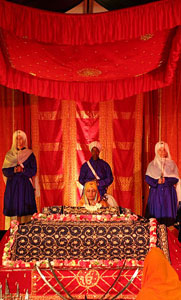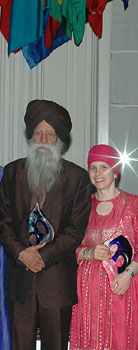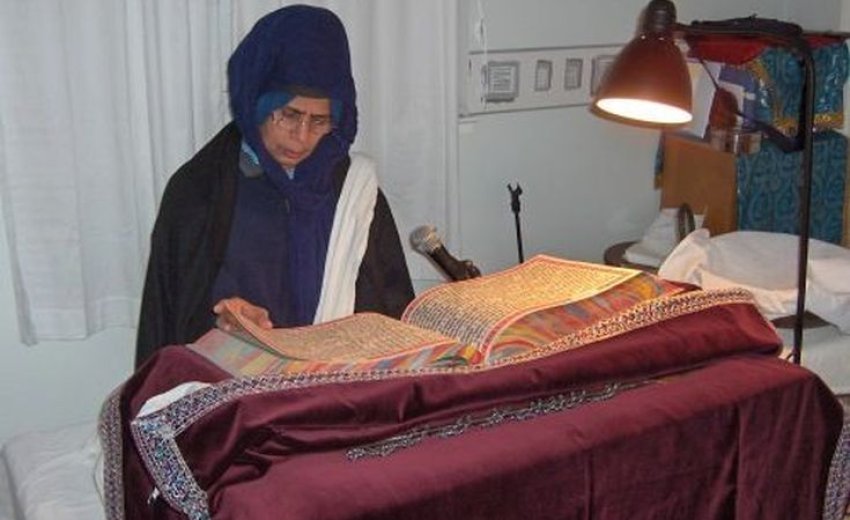 Having been born into a family of another faith, my spiritual journey along the path of Sikhism obviously did not begin along with my very first steps.
Having been born into a family of another faith, my spiritual journey along the path of Sikhism obviously did not begin along with my very first steps.
Growing up in New York City, I learned that the turbanned and bearded gentlemen I saw with increasing frequency were followers of a unique religion called Sikhi (as Sikhism is often referred to by its adherents) - a faith that arose during the 15th century in the Punjab region of India - and not Hindus or Muslims.
But I certainly never imagined that, a few decades later, in my mid-40s, I would joyously embrace Sikhi and become one of the 25 million members of the Sikh faith, the world's fifth largest religion.
My "date with destiny" arrived quite unannounced one evening via the Internet, during research I was doing on a topic of interfaith significance. My initial reaction to Sikhi was absolute love at first sight; I felt instantly magnetized, both intellectually and emotionally.
As I began to insatiably devour everything I could find about Sikhi, I was entranced to encounter it not as an esoteric conglomeration of rigid do's-and-don'ts, but a vibrant spiritual path, universal and timeless.
Like Judaism, Christianity and Islam, Sikhi is a totally monotheistic religion.
The three pillars of the Sikh faith - always keeping God in one's mind and heart, earning an honest livelihood, and sharing one's resources with all those in need - struck me as a simple, rational and relevant "blueprint for everyday life" as an actively engaged, fully contributing member of contemporary society.
The fundamental teachings that Waheguru (as Sikhs refer to God) is an all-pervading Deity, not one limited to any creed, nation, race, color or gender, and that human life is a unique opportunity to discover and nurture the Divine Light residing within all Creation, tremendously appealed to me. I also found the emphasis placed on performing selfless volunteer service quite compelling. Among the many amazingly revolutionary precepts put forth by Guru Nanak, the founder of the faith, and reinforced by the nine Gurus that succeeded him, was the concept of complete gender equality. As a woman, I derived enormous satisfaction from learning that Sikhi accords both sexes the exact same status before God, as well as equal access to scriptures and to positions of Sikh religious and political authority.
Among the many amazingly revolutionary precepts put forth by Guru Nanak, the founder of the faith, and reinforced by the nine Gurus that succeeded him, was the concept of complete gender equality. As a woman, I derived enormous satisfaction from learning that Sikhi accords both sexes the exact same status before God, as well as equal access to scriptures and to positions of Sikh religious and political authority.
As my nascent attraction ripened into a life-altering spiritual quest, I began delving into the exquisite poetic text of Guru Granth Sahib, the compilation of sacred writings imbued with the status of a living, eternal Guru by the tenth and last human Guru, Guru Gobind Singh, in 1708.
Exploring these soul-captivating scriptures and trying to incorporate their teachings into my life connected me with the Divine like never before.
I knew then that I had arrived at one of those "points of no return" that occur so infrequently over a lifetime: my journey of becoming a Sikh had begun.
In order for my bond to be more than just a private, internal one, I knew a solemn, public commitment was necessary. My desire to become a legitimate, recognizable member of the Sikh people, inextricably linked to its history and heritage, finally came to fruition one April morning.
With Waheguru's Grace, on the day before Vaisakhi, a holiday that commemorates the 1699 founding of the Sikh nation by Guru Gobind Singh, I was formally initiated into my chosen faith.
While the joys of being a Sikh woman are many, so are the challenges. Here are just a few examples.
Celebrating the Gurus' gift of complete gender equality entails being vigilant against any forms of discrimination or other encroachment upon women's rights, whether stemming from the mores of the traditional Punjabi or the Indian sub-continental culture in which Sikhi arose, or elsewhere.
Finding ways to effectively educate the public-at-large about Sikhi and Sikhs' distinctive physical appearance is essential to countering the misinformation and intolerance leading to bullying of Sikh schoolchildren and cases of mistaken identity, which, especially after 9/11 (turban-wearing Sikhs being equated with terrorists), have had violent, even deadly consequences. Following the lifestyle of a committed Sikh includes regarding the body as a Divine creation and keeping all hair fully intact, requiring acceptance of concepts of beauty that do not always conform to society's notions of femininity.
Following the lifestyle of a committed Sikh includes regarding the body as a Divine creation and keeping all hair fully intact, requiring acceptance of concepts of beauty that do not always conform to society's notions of femininity.
Embodying the power, grace and dignity inherent in the name given to all Sikh females - Kaur, meaning "princess" - is a challenge we Sikh women successfully face every day.
I feel truly blessed to be one!
[Manjyot Kaur is the Assistant Editor and a regular columnist for the online magazine sikhchic.com. Besides appearing on this and other Sikh-related websites, her book reviews and essays have also been published in Nishaan, The Sikh Review, and Abstracts of Sikh Studies, and were used in conjunction with the materials developed for "Enlighten", the North American Library Project of the Sikh Coalition.]
Courtesy: The Washington Post. This article was originally written for the On Faith column of washingtonpost.com.

